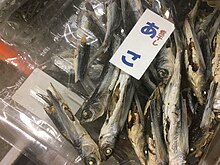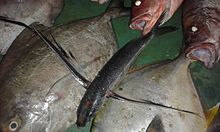
A number of animals are capable of aerial locomotion, either by powered flight or by gliding. This trait has appeared by evolution many times, without any single common ancestor. Flight has evolved at least four times in separate animals: insects, pterosaurs, birds, and bats. Gliding has evolved on many more occasions. Usually the development is to aid canopy animals in getting from tree to tree, although there are other possibilities. Gliding, in particular, has evolved among rainforest animals, especially in the rainforests in Asia where the trees are tall and widely spaced. Several species of aquatic animals, and a few amphibians and reptiles have also evolved this gliding flight ability, typically as a means of evading predators.

Exocoetus is a genus of flying fishes. It is a bony fish. The body is covered with cycloid scales. The mouth is wide, and the jaws bear teeth. It is a marine fish. The tail has hypobatic fins as the ventral lobe.

Hirundichthys is a genus of flying fish. They have elongated, moderately thick, ventrally flattened bodies. The pectoral branch of the lateral line is absent. The upper jaw is not protrusible. The dorsal fin has fewer or equal rays than the anal fin; the dorsal fin is low, with the anterior rays the longest, the pectoral fins are strikingly long, reaching to or almost to caudal fin base; pelvic fins are long, reaching beyond the anal fin origin, and their insertion is closer to the anal fin origin than to the pectoral fin insertion.
Gliding flight is heavier-than-air flight without the use of thrust; the term volplaning also refers to this mode of flight in animals. It is employed by gliding animals and by aircraft such as gliders. This mode of flight involves flying a significant distance horizontally compared to its descent and therefore can be distinguished from a mostly straight downward descent like a round parachute.

The California flying fish, Cheilopogon pinnatibarbatus californicus, is a subspecies of Bennett's flying fish. Prior to the 1970s, the California flying fish was known as a distinct species, with the scientific classification Cypselurus californicus. In fact there are 40 distinct classifications of flying fish. It may grow up to 19 inches (48 cm) in length and is the largest member of the flying fish family. It is found in the Eastern Pacific Ocean, from Oregon to Baja California. As with all other flying fish, the California can not actually fly, but it can launch itself into the air, using its specially adapted fins to glide along the surface.

The mirrorwing flyingfish is a flying fish of the family Exocoetidae. It was first described by the French zoologist, Achille Valenciennes in a 22-volume work titled Histoire naturelle des poissons, which was a collaboration with Georges Cuvier.

The Atlantic flyingfish is a flying fish in the family Exocoetidae. It was first described by the French zoologist, Achille Valenciennes in a 22-volume work entitled Histoire naturelle des poissons, which was a collaboration with fellow zoologist Georges Cuvier.

Certain species of fish and birds are able to locomote in both air and water, two fluid media with very different properties. A fluid is a particular phase of matter that deforms under shear stresses and includes any type of liquid or gas. Because fluids are easily deformable and move in response to applied forces, efficiently locomoting in a fluid medium presents unique challenges. Specific morphological characteristics are therefore required in animal species that primarily depend on fluidic locomotion. Because the properties of air and water are so different, swimming and flying have very disparate morphological requirements. As a result, despite the large diversity of animals that are capable of flight or swimming, only a limited number of these species have mastered the ability to both fly and swim. These species demonstrate distinct morphological and behavioral tradeoffs associated with transitioning from air to water and water to air.

Fodiator is a genus of flying fishes. It is the only genus in the subfamily Fodiatorinae.

Various marine animals are capable of aerial locomotion, i.e., jumping out of the water and moving through air. Some possible reasons for this behavior are hunting, escaping from predators, and saving energy for swimming or breathing. Some of the jumping behaviors initiate gliding and taxiing in air, while some of them end up falling back to water.

The sailfin flying fish is a member of the flying fish family (Exocoetidae). As is typical of other members of its family, this species has the ability to jump out of the water and glide on hypertrophied fins in order to evade predators. It is considered a “two-winged” flying fish, meaning that it only has enlarged pectoral fins, as opposed to “four-winged” flying fish, which have both enlarged pectoral and pelvic fins.
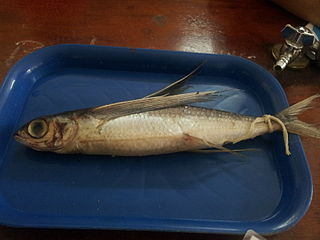
Cheilopogon nigricans, the blacksail flyingfish, also known as African flyingfish, or leaping flyingfish, is a flying fish in the family Exocoetidae. It is an oceanodromous, plankton-eating marine fish which has commercial value.
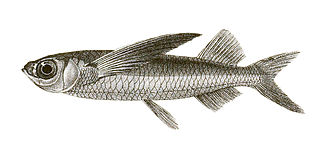
Parexocoetus mento; also known as the African sailfin flying fish, Cuvier's flying fish, the yellow belly flying fish or the short-winged flying fish; is a species of flying fish from the family Exocoetidae which is found in the Indo-pacific region and which has colonised the eastern Mediterranean.
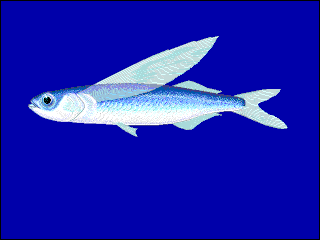
Exocoetus volitans, commonly known as the tropical two-wing flyingfish or blue flyingfish, is a species of ray-finned fish native to tropical and subtropical seas. It can glide above the surface of the sea to escape predators.

Exocoetus obtusirostris, commonly known as the oceanic two-wing flyingfish or the blunt-snouted flyingfish, is a species of ray-finned fish native to the tropical and subtropical western Atlantic Ocean. It has the ability to glide above the surface of the water to escape from predators.

Hirundichthys rondeletii, the black wing flyingfish, is a species of flying fish from the family Exocoetidae which is found throughout the tropical and subtropical waters of the Atlantic, Pacific and Indian Oceans.

Cypsellurinae is a subfamily of flying fishes, one of four in the family Exocoetidae and the only one which is not monogeneric.
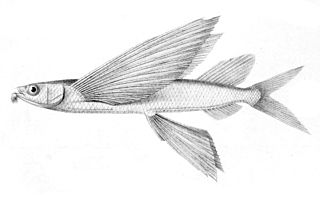
Cheilopogon pinnatibarbatus, Bennett's flying fish, is a species of flying fish which has a circumglobal distribution in tropical and subtropical seas. It is an epiplegaic species which feeds on zooplankton and small fishes and is capable of leaping out of the water and gliding over the surface.
Exocoetus peruvianus, commonly known as the Peruvian flyingfish, is a species of ray-finned fish endemic to the tropical southeast Pacific Ocean in the waters off Peru and Ecuador.



